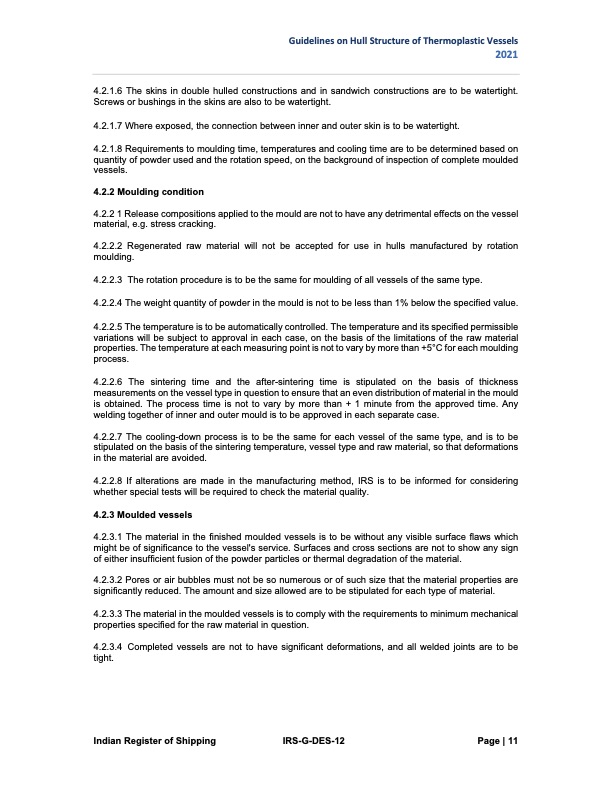
PDF Publication Title:
Text from PDF Page: 011
Guidelines on Hull Structure of Thermoplastic Vessels 2021 4.2.1.6 The skins in double hulled constructions and in sandwich constructions are to be watertight. Screws or bushings in the skins are also to be watertight. 4.2.1.7 Where exposed, the connection between inner and outer skin is to be watertight. 4.2.1.8 Requirements to moulding time, temperatures and cooling time are to be determined based on quantity of powder used and the rotation speed, on the background of inspection of complete moulded vessels. 4.2.2 Moulding condition 4.2.2 1 Release compositions applied to the mould are not to have any detrimental effects on the vessel material, e.g. stress cracking. 4.2.2.2 Regenerated raw material will not be accepted for use in hulls manufactured by rotation moulding. 4.2.2.3 The rotation procedure is to be the same for moulding of all vessels of the same type. 4.2.2.4 The weight quantity of powder in the mould is not to be less than 1% below the specified value. 4.2.2.5 The temperature is to be automatically controlled. The temperature and its specified permissible variations will be subject to approval in each case, on the basis of the limitations of the raw material properties. The temperature at each measuring point is not to vary by more than +5°C for each moulding process. 4.2.2.6 The sintering time and the after-sintering time is stipulated on the basis of thickness measurements on the vessel type in question to ensure that an even distribution of material in the mould is obtained. The process time is not to vary by more than + 1 minute from the approved time. Any welding together of inner and outer mould is to be approved in each separate case. 4.2.2.7 The cooling-down process is to be the same for each vessel of the same type, and is to be stipulated on the basis of the sintering temperature, vessel type and raw material, so that deformations in the material are avoided. 4.2.2.8 If alterations are made in the manufacturing method, IRS is to be informed for considering whether special tests will be required to check the material quality. 4.2.3 Moulded vessels 4.2.3.1 The material in the finished moulded vessels is to be without any visible surface flaws which might be of significance to the vessel's service. Surfaces and cross sections are not to show any sign of either insufficient fusion of the powder particles or thermal degradation of the material. 4.2.3.2 Pores or air bubbles must not be so numerous or of such size that the material properties are significantly reduced. The amount and size allowed are to be stipulated for each type of material. 4.2.3.3 The material in the moulded vessels is to comply with the requirements to minimum mechanical properties specified for the raw material in question. 4.2.3.4 Completed vessels are not to have significant deformations, and all welded joints are to be tight. Indian Register of Shipping IRS-G-DES-12 Page | 11PDF Image | Hull Structure of Thermoplastic Vessels 2021

PDF Search Title:
Hull Structure of Thermoplastic Vessels 2021Original File Name Searched:
guidelines-on-thermoplastic-boats.pdfDIY PDF Search: Google It | Yahoo | Bing
Development of a solar powered Electric Ship The Electricship website originally started off as a project to develop a comprehensive renewable, affordable, modular electric ship... More Info
Modular Boat Hull Composite The case for a unsinkable, modular composite hybrid boat hull... More Info
MS Burgenstock Hybrid Electric Catamaran Lake Lucerne Unique shuttle servicing Lucerne to the Burgenstock Resort... More Info
Ground Power Unit GPU Powered by Lithium Ion Batteries The goal of the Ground Power Unit is to provide a readily accessible, modular, ready-to-power solution for remote power... More Info
| CONTACT TEL: 608-238-6001 Email: greg@electricship.com | RSS | AMP |